We’ve all been there. While we’re all for the idea of embracing our periods as beacons of our womanhood, it becomes increasingly hard to do when you’re doubled over in pain, clutching your tummy which feels tied up in knots from menstrual cramps. You’re not alone. Many women experience painful menstrual cramps. “The experience of cramping is different for everyone who menstruates. There are a lucky few who never experience cramps. However, most experience mild to moderate cramping, and for some, menstrual cramps can be excruciating and debilitating,”says Dr. Joan Berman, OB-GYN.
I turned to Dr. Berman, to explain the science behind what goes down in our lower bellies when it’s that time of the month, and to find out how to get rid of cramps.
Your Be-All, End-All Guide on How to Get Rid of Cramps
-
Your Be-All, End-All Guide on How to Get Rid of Cramps #1

By Sara Spruch-Feiner
We’ve all been there. While we’re all for the idea of embracing our periods as beacons of our womanhood, it becomes increasingly hard to do when you’re doubled over in pain, clutching your tummy which feels tied up in knots from menstrual cramps.
You're not alone. Many women experience painful menstrual cramps. “The experience of cramping is different for everyone who menstruates. There are a lucky few who never experience cramps. However, most experience mild to moderate cramping, and for some, menstrual cramps can be excruciating and debilitating,” says Dr. Joan Berman, OB-GYN.
I turned to Dr. Berman, to explain the science behind what goes down in our lower bellies when it’s that time of the month.
-
Cramps: What Are They and Why Do We Get Them?
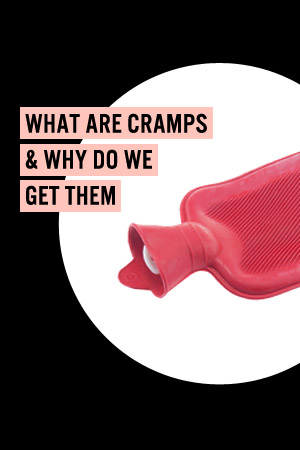
“Menstrual cramps are generally caused by the release of a hormone-like substance called prostaglandin,” she explains. “Prostaglandin causes inflammation and pain." As an added bonus (not) it can also cause the uterus to contract and cut of its blood supply temporarily, which can increase your pain even more. Eeek.
-
How Your Gynecologist Can Help
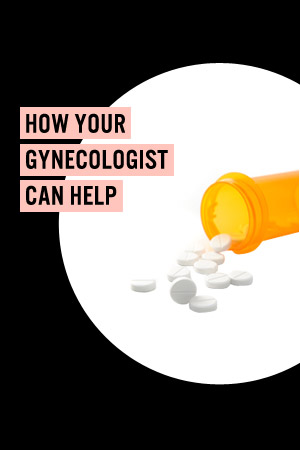
“For many, the birth control pill is an extremely effective way to prevent cramps because it prevents the cyclic hormonal changes that cause them,” Dr. Berman says.
She also says that hormonal IUDs, like Mirena and Skyla, can also help. "All of these methods have been used to treat cramping for those who do not need contraception.”
Over-The-Counter Options
However, if you simply don’t want to use a birth control method at the moment, the most effective treatment is the class of drugs called NSAIDs, which stands for non-steroidal anti-inflammatory drugs. This group of drugs include the over the counter medications, ibuprofen (Advil), naproxin (Aleve), and aspirin. Some women are unable to take these medications due to an allergy, a history of acid reflux or stomach ulcers. “Remember to always follow the instructions for dosage because they can have serious side effects if used improperly,” Dr. Berman advises.
Treat Early
The best way to medicate is to begin before the cramps are severe because “in addition to relieving pain, the production of prostiglandin is inhibited by the NSAIDs,” Dr. Berman explains. She advises: “For those who have predictable, severe cramping, I recommend beginning them a day before the period is due, or as soon as the first blood is seen or cramp is felt. The dosing should be round-the-clock for the days that the cramps are most severe and then as-needed as they subside. Because these medications can cause irritation of the lining of the stomach, they should be taken with food and stopped if you develop pain in the abdomen.”
-
Consider Your Diet
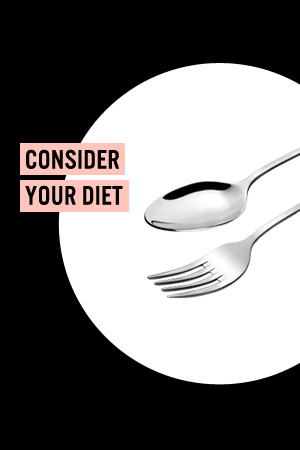
If the pain is present but mild enough that you don’t want to take pills, or if you know you need pills but want to make an effort to try other methods of relief too, you may want to examine your diet. I spoke with expert nutritionist, Lauren Minchen, M.P.H., R.D., C.D.N., about how to tweak your diet to help your period.
Echoing Dr. Berman’s advice regarding pre-emptive medication, it’s best to tweak your diet before PMS even hits. “Feeding a steady supply beforehand may be more beneficial than an emergency dose after the pain has already set in,” Minchen notes.
-
There’s Nothing Like A Good Cuppa Hot Tea
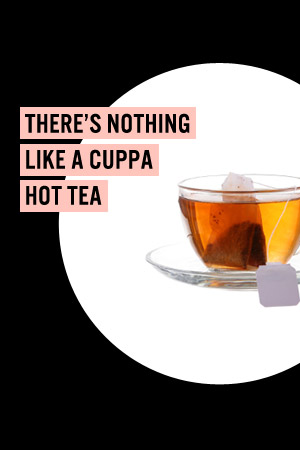
Menstrual cramps are largely a result of muscle contracting and constricting of blood vessels. “Hot liquids can be helpful for relaxing blood vessels and relieving muscle tension,” Minchen explains. She describes them as “a hot water bottle for your insides!” She recommends green tea, hot water with lemon, and white tea.
-
More Minerals
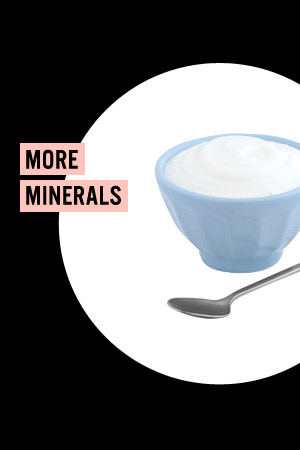
Calcium and magnesium can also be helpful for relieving menstrual cramps. “These two minerals interact with muscle tissue and can reduce the pain associated with muscle contractions,” Minchen explains. Good sources of both of these minerals include: unsweetened Greek yogurt, cottage cheese, dark leafy greens (think: spinach, kale, swiss chard, collard greens), almonds, broccoli, sunflower seeds, and (score!) even hot chocolate made with cacao powder and organic whole milk.
-
More (Good) Fats
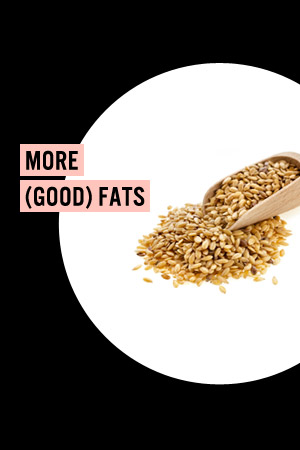
Omega-3 fats may be helpful for reducing inflammation and associated pain that pops up with PMS, Minchen explains. Incorporating foods like wild salmon, flax seed, chia seeds, wild sardines, and seafood into your diet can provide a healthy dose of Omega-3s.
-
Yoga for Your Period
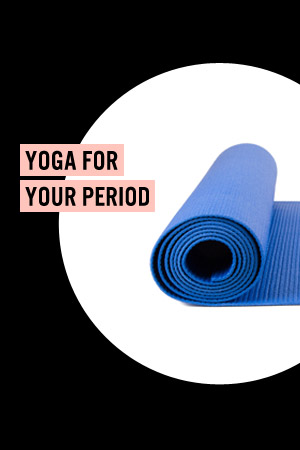
Though exercising might be one of the last things you want to think about when you’re cramping and have your period, the fact is that it can relieve muscle tension and increase oxygen flow to the cells, which can ultimately reduce menstrual pain. Going for a walk can help, but I consulted exhale’s National Yoga Director, Stefanie Eris, for tips on the best asanas to relieve cramp pain.
“A yoga practice is a wonderful way to support yourself each month of your cycle. Yoga teaches us to stop fighting nature, and instead to embrace our bodies’ natural rhythm,” Eris says. “A flowing practice is a sweet way to link your attention, body, and breath, and help to coax you to a place of rest. Instead of fighting your body while you're on your cycle, honor it. Use this time to take care of yourself, let yourself rest a bit more than you're used to, and maybe, once you learn to appreciate your natural rhythms, your symptoms won't feel so severe.”
Next, a few poses that can ease your cramps when they do come up.
-
Malasana
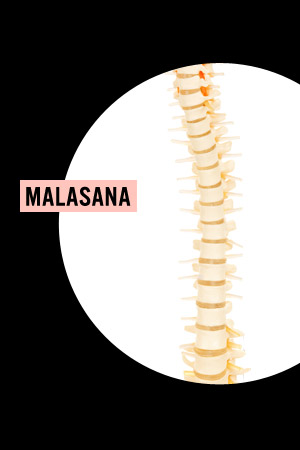
Why it’s good for you: Yogi squats are great poses for you anytime, but are especially beneficial during your cycle. This pose helps to relax and lengthen the pelvic floor muscles -- helping you to bear down internally and activate the downward flow of energy (apana vayu). It also helps move your digestion along if you have belly aches/digestive issues by elongating the colon.
How to do it: Separate your feet approximately mat width apart. Turn your feet out ever so slightly. Maintaining a long spine, bend your knees and flex at your hips until you can rest your elbows on your thighs. If you have knee pain or your heels pop off the floor, keep your pelvis knee height. To go deeper, sink your pelvis down below the knees and bring your hands to prayer at your heart. Keep your weight in your feet, and send your breath deep down into your pelvic bowl.
-
Supported Bridge

Why it’s good for you: This pose is a lifesaver, and my go-to shape for cramps. This shape helps you breathe space into your low belly and pelvic bowl. It also gently lengthens the low back, which tends to get stiff and achy for many women.
How to do it: Lie down on your back with your knees bent, heels in line, with your sits bones stacked just under your knees. Lift your pelvis off the floor enough to slide a block (or a stack of books) under your sacrum, the fused set of vertebrae that makes up the back wall of your pelvis. Keep the block on its lowest setting turned perpendicular to your spine. Rest here as long as you'd like!




